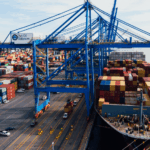Introduction to the Global Carbon Levy on Shipping
As someone who has spent over two decades working with corporations and institutions on ESG and sustainability strategies, I’ve seen how complex yet vital global cooperation is when it comes to emissions pricing. The global carbon levy on shipping, now under negotiation by the International Maritime Organization (IMO), is one such example of both progress and pause.
This proposed mechanism, essentially a fee on every ton of carbon emitted by ships, aims to make cleaner fuels more competitive and to finance the global transition toward sustainable maritime trade. Yet, the recent U.S. opposition has temporarily frozen the talks. The concern is largely economic: potential impacts on trade costs and fuel prices.
Still, from an ESG perspective, this development shouldn’t be seen as a setback, but as a moment to refine the policy’s fairness, transparency, and inclusiveness.
Benefits of a Global Carbon Levy
The global shipping industry accounts for nearly 3% of annual CO₂ emissions, more than aviation. Without decisive action, that number could double by 2050. A well-designed carbon levy would address three key challenges:
-
Accelerating clean fuel adoption
The levy creates a market signal that rewards low-emission fuels like green methanol and ammonia. Early adopters such as Maersk and CMA CGM have already begun investing in dual-fuel vessels, anticipating carbon costs. -
Ensuring fair competition
A global framework avoids a patchwork of regional rules that complicate compliance. For companies already aligning with ESG frameworks such as GRI, ESRS, or SASB, this harmonization would provide greater reporting consistency and operational predictability. -
Financing climate equity
Revenue from the levy could be directed toward developing countries and small island states, helping them adapt to climate impacts while ensuring no one is left behind in the transition. This aligns closely with the UN Sustainable Development Goals (SDGs), particularly SDG 13 (Climate Action) and SDG 9 (Industry, Innovation, and Infrastructure).
Practical Steps and Best Practices
The momentum toward maritime decarbonization continues despite political delays. Several positive developments are already shaping the industry’s future:
-
Regional carbon pricing:
The European Union’s inclusion of shipping emissions in its Emissions Trading System (ETS) as of 2024 serves as both a pilot and a pressure point. It shows how carbon markets can operate effectively while maintaining competitiveness. -
Voluntary corporate leadership:
Companies like Hapag-Lloyd and NYK Line are setting internal carbon prices, preparing for future regulation. Such early action often results in cost savings and reputational advantage, a key ESG value driver. -
Financial collaboration:
Initiatives such as the World Bank’s Blue Shipping Fund and the Poseidon Principles are linking lending decisions to carbon intensity, effectively embedding sustainability into financial systems.
Example: Common Mistakes to Avoid
The most common policy pitfall is fragmentation. Without a unified global levy, regional measures may overlap, creating inconsistent pricing and compliance confusion. The lesson is clear: global rules need local flexibility, not fragmentation.
A Broader Perspective: Why the Pause Could Be Constructive
While the U.S. resistance at the IMO level has delayed consensus, this pause offers an opportunity for deeper dialogue. The debate highlights legitimate questions: Who bears the cost? How do we protect small economies? That need addressing for the system to be truly sustainable.
Moreover, the private sector is no longer waiting. Green shipping corridors, such as those supported by the World Economic Forum’s First Movers Coalition, are emerging as transitional models. These collaborations demonstrate that business innovation can lead policy, not just follow it.
As I often emphasize in corporate ESG trainings, policy lag is not the same as policy failure. The global carbon levy remains one of the most promising mechanisms to integrate environmental responsibility into trade economics.
FAQs
What is the global carbon levy on shipping in simple terms?
It’s a fee imposed on ships for each ton of CO₂ emitted, designed to make cleaner fuels cheaper and to fund the decarbonization of global maritime trade.
How long will it take to implement the levy?
If negotiations resume in 2026, implementation could begin by 2030, aligning with the IMO’s 2050 target for net-zero greenhouse gas emissions.
Is the carbon levy worth it for economic growth?
Yes. A global levy can stimulate clean innovation, attract sustainable finance, and reduce long-term costs associated with climate-related disruptions, ultimately strengthening trade resilience.
Conclusion
The global carbon levy on shipping remains more than just a technical policy; it symbolizes the future of accountable trade. Delays may slow progress, but they also ensure the mechanism is built on equity, efficiency, and shared responsibility.
In my view, this pause should be used to design a levy that is both economically sound and socially fair, a tool that aligns climate ambition with global trade realities.
The course of maritime sustainability is set. It’s not a question of if decarbonization happens, but how quickly and inclusively we achieve it.









